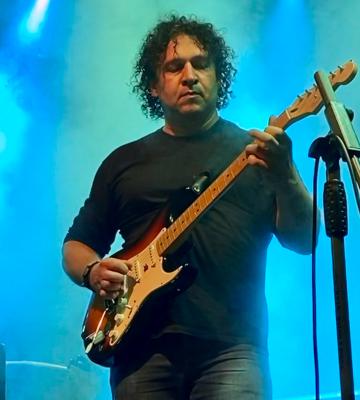now playing:
More
- When the Guitar CriesLEVEL 4The first in a row of lessons illustrating vibratos, a very important technique.
- When The Guitar Cries 3LEVEL 7This is the third in a series dealing with vibratos.
- When The Chariot ComesLEVEL 2Learn how to play a spiritual song!
- Oh When The SaintsLEVEL 1We look at the traditional piece 'Oh When the Saints' building a better relationship between fingers 1 and 3 on the fretting hand.
- When Johnny ComesLEVEL 2A nice and easy traditional American folk song for beginners.
- Green Day: When I Come AroundLEVEL 2Easy and catchy song to play, perfect for beginners!
- The Voice Of Your GuitarLEVEL 4Build guitar melodies that resemble vocal lines.
- Notes On The GuitarLEVEL 1Learn the names of the notes and where each note is on the guitar fretboard.
- Celtic Guitar 2LEVEL 3The 2nd part of this series focused on Celtic Music.
Feedback
 thefireball26th March 2012
thefireball26th March 2012Beautiful!!!
 Marcus Siepen27th January 2010
Marcus Siepen27th January 2010perfect lesson, great job
 Sergio Dorado21st January 2010
Sergio Dorado21st January 2010Absolutely amazing!
 Pedja Simovic13th January 2010
Pedja Simovic13th January 2010Fantastic lesson Krisztian!
 Laszlo Boross13th January 2010
Laszlo Boross13th January 2010Great playing and perfect sounding! Very nice lesson Krisztian!

 Zsolt Galambos13th January 2010
Zsolt Galambos13th January 2010This is even better than the previous one! Such exposive emotions, perfect phrasing, man

 Krisztian Lovrek12th January 2010
Krisztian Lovrek12th January 2010Thank you my friends!!!
 Alexiaden9312th January 2010
Alexiaden9312th January 2010Very emotional and cool sounding lesson, Krisztian !
 I really enjoy listening to your playing
I really enjoy listening to your playing 
 playaxeman12th January 2010
playaxeman12th January 2010Great emotional playing my friend.
I really enjoyed watching and listing to it
Some really great slow part mixed with some fast past, great
Really love this style of playing. You have a great sound there. Wilska12th January 2010
Wilska12th January 2010beautiful Kristztian, very touching. You're great at expressing yourself through the guitar. And the tone was great aswell. Loved it!
 Bluesberry12th January 2010
Bluesberry12th January 2010Reminds me of Joe Satriani for one reason or another.
Absolutely brilliant emotion and the technique to express it. Fran12th January 2010
Fran12th January 2010Awesome, really emotional and inspiring!
 kaznie_NL12th January 2010
kaznie_NL12th January 2010Krisztian.... WOW!!!!! dude....
I really love the slow phrases in this one, and the faster parts are played with superb technique and fit the backing track excellently! Nice sweeps
AWESOME!!!!! Vasilije Vukmirovic12th January 2010
Vasilije Vukmirovic12th January 2010Sounds great!

 Ivan Milenkovic12th January 2010
Ivan Milenkovic12th January 2010Awesome phrasing, techniques, tone and backing. Great lesson for anyone looking to add expressiveness to his playing.
 Bogdan Radovic12th January 2010
Bogdan Radovic12th January 2010Amazing feeling in this one!: )
 Piotr Kaczor12th January 2010
Piotr Kaczor12th January 2010Absolutely brilliant playing, Krisztian!
 mhskeide12th January 2010
mhskeide12th January 2010I don`t have any adjectives which truly describes the awesomeness of the piece, it`s just mindblowing

Thanks a lot
 MirkoSchmidt12th January 2010
MirkoSchmidt12th January 2010wonderful! sounds amazing!
 Kristofer Dahl12th January 2010
Kristofer Dahl12th January 2010Wow absolutely mindblowing phrases, runs and tone - very inspirational, thanks Krisztian!
- Lesson
- My notes
Welcome to the next vibrato lesson, When The Guitar Cries II.
I started this series to teach how to play notes in a right way, and how can we give power into our music.
The first part was very easy, without any hard and fast run.
Right now I'd like to show you how can we combine the melodies with some technically difficult parts, how it is possible to make it much more powerful with these runs.
The first thing is: we need to choose what we want to express with our playing.
In this case I wanted to express how I loved my grandfather István Bodacz, who was my father instead of my "real" father(s)..and who died last December. I couldn't comprehend this thing, and maybe I never will, but I wanted to do something which can express what I feel. I think now it's done.
I hope that he sees, hears and smiles over there. I have a lot to thank him for, so, I'd like to dedicate this 'lesson' to him! I also hope that you will like it!
Let's approach it with regards to the lesson!
My first vibrato lesson was in 4/4, but now the time is 6/8.
The guitar tuning is standard D. ( D-G-C-F-A-D ), and the key is E minor.
As usual I used a lot of techniques like
-slides
-palm muting
-legato
-alternate picking
-tapped harmonic
-sweep picking
-wide vibrato
-pinch harmonic (artificial harmonic)
-vibrato with whammy bar
-bendings
-pull off and hammer on
As you can see this lesson contains almost all of the techniques that we use in electric guitar playing.
I built up this solo with 4 fast runs with different techniques. (pull off-hammer-on, alternate picking, sweep picking, legato )
The timing is very important! In my opinion it is much more difficult to play slowly than fast, because you can't hide your mistakes by the speed.
If you play a million notes per minute your average viewer can't notice your mistakes, but if you play only a few notes everybody can hear them, that's why it is very important to practice playing slow.
To use this backing track you can write and build up your solo with your own ideas, based on my ideas and solutions.
In this solo I used pentaton scale, blues scale, minor scale, and hirajoshi scale.
Happy practicing!
KriszFrom this course:
Jump to start: Home or `s` , you can also click/tap the lesson part again (the numbers above player)
Go to next part: PageUP or End.
Volume: ArrowUp / ArrowDown keys
Go to any part: Number keys (combinations also possible)
Pause or play: `k` or space key
Fullscreen: `f`, esc to close
Increase / decrease speed : `+` or `-`







